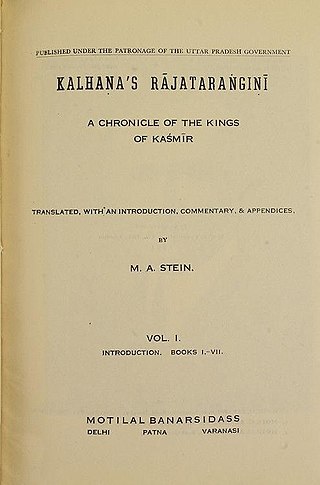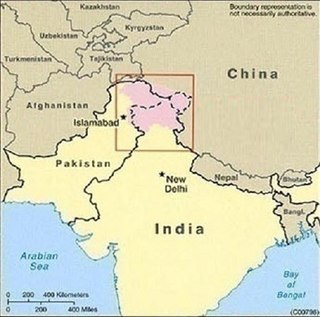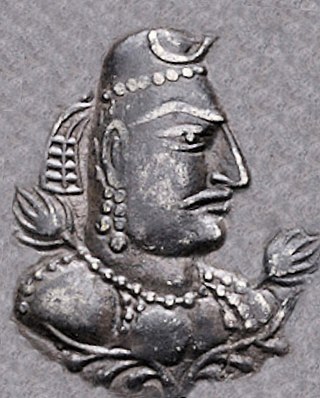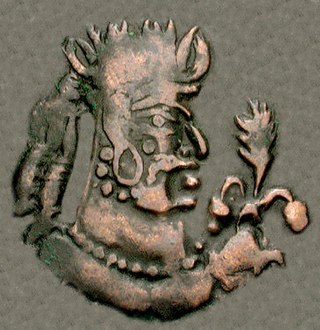
Lalitaditya alias Muktapida was a Kashmiri monarch belonging to the Karkota dynasty of Kashmir region in the Indian subcontinent. The Tang dynasty chronicles present him as a vassal-ally of the Tangs. Lalitaditya acknowledges himself as vassal and submitted to the Tang Emperor of China in the Tang chronicles. However it's debated whether he was actually a Tang vassal knowing the Tang's history of exaggerations.

Rājataraṅgiṇī is a metrical legendary and historical chronicle of the north-western part of Indian sub-continent, particularly the kings of Kashmir. It was written in Sanskrit by Kashmiri historian Kalhana in the 12th century CE.

Buddhism was an important part of the classical Kashmiri culture, as is reflected in the Nilamata Purana and Kalhana's Rajatarangini. Buddhism is generally believed to have become dominant in Kashmir in the time of Emperor Ashoka, although it was widespread there long before his time, enjoying the patronage not only of Buddhist rulers but of Hindu rulers too. From Kashmir, it spread to the neighbouring Ladakh, Tibet and China proper. Accounts of patronage of Buddhism by the rulers of Kashmir are found in the Rajatarangini and also in the accounts of three Chinese visitors to Kashmir during 630-760 AD.

Harsha, also Harshadeva, was a Hindu king of Kashmir. He was given the epithet "raja-Turushka".

Didda, also known as The Catherine of Kashmir, was the last ruler of Utpala dynasty from 980 CE to 1003 CE. She first acted as regent for her son and various grandsons from 958 CE to 980 CE, and from 980 CE as sole ruler and monarch. Most knowledge relating to her is obtained from the Rajatarangini, a work written by Kalhana in the twelfth century.

Sugandha was the fifth ruler of Kashmir in the northern Indian subcontinent during the 10th century.
The Hindu Shahis also referred to as the Uḍi Śāhis were a dynasty established between 843 CE and 1026 CE. They endured multiple waves of conquests for nearly two centuries and their core territory was described as having contained the regions of Eastern Afghanistan and Gandhara, encompassing the area up to the Sutlej river in modern day Punjab, expanding into the Kangra Valley. The empire was founded by Kallar in c. 843 CE after overthrowing Lagaturman, the last Turk Shahi king.

The Lohara dynasty was a Kashmiri Hindu dynasty that ruled over Kashmir and surrounding regions in the northwestern part of the Indian subcontinent for more than 3 centuries between 1003 CE and approximately 1320 CE. The early history of the dynasty was described in the Rajatarangini, a work written by Kalhana in the mid-12th century and upon which many and perhaps all studies of the first 150 years of the dynasty depend. Subsequent accounts, which provide information up to and beyond the end of the dynasty, come from Jonarāja and Śrīvara. The later rulers of the dynasty were weak; internecine fighting and corruption were endemic during this period, with only brief years of respite, making the dynasty vulnerable to the growth of Islamic conquests in the region.
Aryaraja was a king of Kashmir who features in Rajatarangini, a legendary and historical chronicle of the north-western Indian subcontinent, particularly the kings of Kashmir. It was written in Sanskrit by Kashmiri historian Kalhana in the 12th century CE.
The Nilamata Purana, also known as the Kasmira Mahatmya, is an ancient text from Kashmir which contains information on its history, geography, religion, and folklore. It was used by Kalhana as one of sources of his history.
The Karkota dynasty ruled over the Kashmir valley and some northern parts of the Indian subcontinent during 7th and 8th centuries. Their rule saw a period of political expansion, economic prosperity and emergence of Kashmir as a centre of culture and scholarship.

Jalauka was, according to the 12th century Kashmiri chronicle, the Rajatarangini, a king of Kashmir, who cleared the valley of oppressing Malechas. Jaluka was reputed to have been an active and vigorous king of Kashmir, who expelled certain intrusive foreigners, and conquered the plains as far as Kannauj. Jalauka was devoted to the worship of the Hindu god Shiva and the Divine Mothers, in whose honour he and his queen, Isana-devi, erected many temples in places which can be identified.Ashoka’s death his mighty empire had fragmented into as many as four or five regional kingdoms each ruled by his sons or grandsons, among them Jalauka in Kashmir, who reversed his father’s policies in favour of Shaivism and led a successful campaign against the Graeco-Bactrians, themselves seeking to take advantage of the power vacuum in north-west India to reclaim Taxila.

The Utpala Dynasty was a medieval dynasty that ruled over Kashmir from the 9th to 10th centuries. Founded by Avantivarman in 855 CE, it replaced the Karkota dynasty. It came into existence in the northern region of the Indian subcontinent. The cities of Avantipur and Suyapur were founded during the reign, and many Hindu temples dedicated to both Vishnu and Shiva and Buddhist monasteries were built, notable of which is the Avantiswara and Avantiswami temples.

The Alchon Huns, also known as the Alkhan, Alchono, Alxon, Alkhon, Alakhana, and Walxon, were a nomadic people who established states in Central Asia and South Asia during the 4th and 6th centuries CE. They were first mentioned as being located in Paropamisus, and later expanded south-east, into the Punjab and Central India, as far as Eran and Kausambi. The Alchon invasion of the Indian subcontinent eradicated the Kidarite Huns who had preceded them by about a century, and contributed to the fall of the Gupta Empire, in a sense bringing an end to Classical India.
The Second Gonanda dynasty, was a Kashmiri Hindu dynasty. According to Kalhana, this dynasty ruled Kashmir just before the Karkotas.

Sankaravarman was a ruler of the Utpala dynasty, which ruled over the Kashmir region from 8th to 10th century CE. The kingdom was established by Avantivarman, who ended the rule of Karkota dynasty in 855 CE.

Sri Pravarasena, also sometimes Pravarasena II based on the regnal lists of the Rajatarangini, was a 6th-century Huna king of the Alchon Huns in the area of Gandhara and Kashmir in northwestern India. His reign probably lasted about 60 years from about the year 530 CE.
Yudhishthira has been proposed as the last Alchon Hun ruler of Kashmir, according to a reconstruction made by Atreyi Biswas. The tentative identification has been made from the lists of Huna kings given in the Puranas and the Rajatarangini.

Toramana II was a ruler of the Alchon Huns in the 6th century CE.

Toramana of Kashmir, was a ruler of Kashmir in the 6-7th century CE. This ruler has often been called "Toramana II" in numismatic studies, but this name now tends to be used for an earlier Alchon Hun ruler of Kabulistan: Toramana II.












